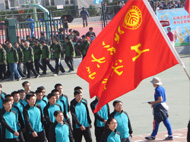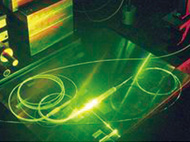题目:Device Fabrication and New Material Synthesis in Bionanotechnology Approach; Biomimetic Assemblies of Peptide Nanowires and Nanoparticles and Their Controlled Mineralization with Semiconductors at Room Temperature
时间:2008年7月7日 星期一上午10:00
地点:力学楼会议室(434)
主讲人:Hiroshi Matsui, Associate Professor
Department of Chemistry, City University of New York, Hunter College
主持人: 侯仰龙 特聘研究员
摘要
Non-lithographic fabrications of devices such as electronics and sensor have been studied extensively by assembling nanometer-sized building blocks into the device configurations. While various nanowires and nanoparticles with superior physical properties have been synthesized as the building blocks, more reproducible methods to assemble them onto precise positions are desirable to construct nanodevices. We developed triple helix peptide nanowires as multifunctional smart building blocks, and we used recombinant technology to design them in uniform length and diameter. The quantity of peptide nanowire was amplified by E. coli expression system. We designed these nanowires to incorporate biomolecular recognition components (antibody), and our strategy is to use those functionalized peptide nanowires, which can recognize and selectively bind a well-defined region on antigen-patterned substrates, as building blocks to assemble nanoscale architectures at uniquely defined positions. In order for the application in electric device fabrications, after configuring device geometries with these nanotubes by the biomolecular recognition, we turned on the biomineralization function of peptides on the nanotube sidewall to develop various material coatings such as metals and semiconductors for electronics and sensor applications. It should be noted that the coating morphology such as particle-domain size and inter-particle distance on the nanotubes could be tuned by peptide sequences and conformations. Due to these peptides’ catalytic function, some semiconductor coatings could be developed at room temperature on the nanotube. In addition to the nanowire, we also produced various nanoparticles by using ring-shaped peptide assemblies as enzymatic templates. These nano-rings mimic the nature to grow crystals inside the cavities at room temperature, which normally require high temperature to grow by other synthetic methods. This approach was demonstrated to grow various nanocrystals such as ZnO, BaTiO3 and ?-Ga2O3 at room temperature. These nano-rings could also be self-assembled as an array on substrates by the similar strategy used for the biomimetic nanowire array formation.
报告人简介:
Hiroshi Matsui, Ph.D.
Associate Professor of Chemistry and Biochemistry, The City University of New York (CUNY), Hunter College, 695 Park Avenue, New York, NY 10021. Tel. (212) 660-3918. Fax (212) 772-5332.
E-mail hmatsui@hunter.cuny.edu.
Website: http://www.hunter.cuny.edu/chem/faculty_files/matsui/matsui.html
Professional Preparation
Sophia University Chemistry B.S. 1987
Stanford University Materials Science M.S. 1992
Purdue University Chemistry Ph.D. 1996
Ph.D. Advisors: Professor Edward R. Grant
Columbia University Chemistry Postdoc 1996-1998
Postdoctoral Advisor: Professor James J. Valentini
Appointments
CUNY/Hunter College Associate Professor 2004– current
CUNY/Hunter College Assistant Professor 2001– 2004
DuPont Company. Technical Reps at Medical & Polymer Depts. 1987 – 1991
Synergistic Activities
1. A session organizer of the Gordon Research Conference, “Peptides: Biology & Chemistry of” (2008).
2. Organizer for annual meeting for Frontiers of Engineering, National Academy of Engineering (2006).
3. Organizing the American Chemical Society National Meeting (San Diego, March 2005): the Polymer Materials and Science Engineering (PMSE), Bionanotechnology section.
4. Serving as a review panel member for the NSF in the QuBIC program (2001-2005).
5. External panel review member: U.S. National Science Foundation, Biocomputing, The U.S. Air Force Research Laboratory, Biotechnology group (2004).
6. A faculty member in the Summer Program for Undergraduate Research of the Gene Center at Hunter College that focuses on minority undergraduates under-represented in Science.
7. A faculty member in Minority Biomedical Research Scholarship (MBRS program) at Hunter College.
8. A committee member of NY Academy of Science in Nanotechnology Division (2003 - current).
Awards
1. Elected member in Frontiers of Engineering Symposium (National Academy of Engineering) (03’, 06’)
2. JSPS (Japan Society for the Promotion of Science) Fellow (03’, 06’)
3. National Science Foundation CAREER Award (2002-08)
4. David Ross Fellowship (1996)
Publications: 64 archival journal publications; 8 review articles.
Selected Publications Related to this proposal (25 out of 72)
1. “Enzyme Urease as Nano-Reactor to Grow Crystalline ZnO Nanoshells at Room Temperature”, R. de la Rica and H. Matsui, Angew. Chem. Intl. Ed., 47, (early view on web, http://dx.doi.org/10.1002/anie.200801181, (2008).
2. “Comparison of Electrical Properties of Viruses Studied by AC Capacitance Scanning Probe Microscopy”, R.I. MacCuspie, N. Nuraje, S-Y. Lee, A. Runge, and H. Matsui, J. Am. Chem. Soc., 130, 887-891(2008).
3. “Liquid/liquid interfacial epitaxial polymerization to grow single crystalline nanoneedles of various conducting polymers”, N. Nuraje, S. Kai, N.L. Yang and H. Matsui, ACS Nano, 502-506 (2008).
4. ”Crossbar Assembly of Antibody-Functionalized Peptide Nanotubes via Biomimetic Molecular Recognition”, L. Yang, N. Nuraje, H. Bai, H. Matsui, J. Pep. Sci., 203-207 (2008).
5. “Virus Assay Using Antibody-Functionalized Peptide Nanotubes”, R.I. MacCuspie, I.A. Banerjee, S. Gummalla, H.S. Mostowski, P.R. Krause, and H. Matsui, Soft Matter, 803-806 (2008).
6. “Fabrication of Au nanowire of uniform length and diameter using a new monodisperse and rigid biomolecular template, collagen-like triple helix”, H. Bai, K. Xu, Y. Xu, and H. Matsui, Angew. Chem. Intl. Ed., 46, 3319-3321 (selected as a hot paper) (2007).
7. “Mineralization of semiconductor nanocrystals on peptide-coated bionanotubes and their pH-dependent morphology changes”, I.A. Banerjee, G. Muniz, S-Y. Lee, and H. Matsui, J. Nanosci. Nanotechnol, 7, 2287-2292 (2007).
8. “Highly Accurate Immobilization of Antibody Nanotubes on Protein-Patterned Arrays with Their Biological Recognition by Tuning Their Ligand-Receptor Interactions”, Z. Zhao, H. Matsui, Small, 3, 1390-1395 (2007).
9. “Catalytic growth of silica nanoparticles in controlled shapes at planar liquid/liquid interfaces”, N. Nuraje, K. Su, and H. Matsui, New J. Chem., 31, 1895-1899 (2007).
10. “Self-Assembly of Au Nanoparticle-Containing Peptide Nano-Rings on Surfaces”, N. Nuraje, K. Su, J. Samson, A. Haboosheh, R.I. MacCuspie and H. Matsui, Supramol. Chem., 18, 429-435 (2006). (the top 10 most accessed article in 2006 in Supramol. Chem.)
11. “Room Temperature-Synthesis of Ferroelectric Barium Titanate Nanoparticles Using Peptide Nano-Rings as Templates”, N. Nuraje, K. Su, A. Haboosheh, J. Samson, E.P. Manning, N-L. Yang, and H. Matsui, Adv. Mater., 18, 807-811 (2006).
12. “Peptide-Based Nanotubes and Their Applications in Bionanotechnology”, X. Gao, H. Matsui, Adv. Mater., 17, 2037-50 (2005).
13. “Fabrication and Application of Enzyme-Incorporated Peptide Nanotubes”, L. Yu, I.A. Banerjee, X. Gao, N. Nuraje, H. Matsui, Bioconjugate Chem., 16, 1484-89 (2005).
14. “Simultaneous Targeted Immobilization of Anti Human-IgG-Coated Nanotubes and Anti Mouse-IgG-Coated Nanotubes on the Complementary Antigen-Patterned Surfaces via Biological Molecular Recognition”, Z. Zhao, I.A. Banerjee, H. Matsui, J. Am. Chem. Soc., 127, 8930-31 (2005).
15. “Fabrication and Application of Enzyme-Incorporated Peptide Nanotubes”, L. Yu, I.A. Banerjee, X. Gao, N. Nuraje, H. Matsui, Bioconjugate Chem., 16, 1484-1489 (2005).
16. “Biological Bottom-Up Assembly of Antibody Nanotubes on Patterned Antigen Arrays”, N. Nuraje, I.A. Banerjee, R.I. MacCuspie, L. Yu and H. Matsui, J. Am. Chem. Soc., 126, 8088-89 (2004). (the Most-Accessed Article in JACS in 2007, http://pubs.acs.org/journals/jacsat/promo/most/most_accessed/index.html)
17. “Attachment of Ferrocene Nanotubes on ?-CD Self-Assembled Monolayers with Molecular Recognitions”, Y-f Chen, I.A. Banerjee, R, Djalali, L. Yu, H. Matsui, Langmuir, 20, 8409 (2004).
18. “Doughnut-Shaped Peptide Nano-Assemblies and Their Applications as Nanoreactors”, R. Djalali, J. Samson, H. Matsui, J. Am. Chem. Soc., 126, 7935 (2004).
19. “Cu Nanocrystal Growth on Peptide Nanotubes via Biomineralization: Size Control of Cu Nanocrystals by Tuning Peptide Conformation”, I.A. Banerjee, L. Yu, H. Matsui, Proc. Natl. Acad. Sci. USA, 100, 14678-682 (2003).
20. “Application of Host - Guest Chemistry in Nanotube-Based Device Fabrication: Photochemically Controlled Immobilization of Azobenzene Nanotubes on Patterned ?-CD Monolayer/Au Substrates via Molecular Recognition”, I.A. Banerjee, L. Yu, H. Matsui, J. Am. Chem. Soc., 125, 9542 (2003).
21. “Au Nanocrystal Growth on Nanotubes Controlled by Conformations and Charges of Sequenced Peptide Templates”, R. Djalali, Y-F, Chen, H. Matsui, J. Am. Chem. Soc., 125, 5873-79 (2003).
22. “Location-specific biological functionalization on nanotubes: Attachment of proteins at ends of nanotubes using Au nanocrystal masks”, I.A. Banerjee, L. Yu, H. Matsui, Nano Lett., 3, 283 (2003).
23. “Au Nanocrystal Growth on Nanotubes Controlled by Conformations and Charges of Sequenced Peptide Templates”, R. Djalali, Y-F, Chen, H. Matsui, J. Am. Chem. Soc., 125, 5873 (2003).
24. “Au Nanowire Fabrication From Sequenced Histidine-Rich Peptide”, R. Djalali, Y-F, Chen, H. Matsui, J. Am. Chem. Soc., 124, 13660-13661 (2002).
25. “Size-controlled peptide nanotube fabrication using polycarbonate membranes as templates”, P. Porrata, E. Goun, H. Matsui, Chem. Mater., 14, 4378-4381 (2002).
联系人:侯仰龙, hou@pku.edu.cn
电话:010-8252-9028
http:/subpaget.asp?id=69









